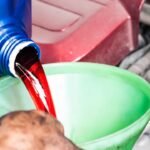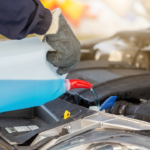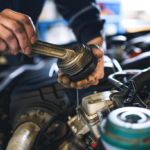Summer is the perfect time to hit the road and explore the world with your car. However, summer can also bring a lot of challenges that can affect your vehicle’s performance, especially if you are a beginner driver.
That’s why it’s crucial to have proper maintenance for your car during this season. Car maintenance may seem like a daunting task at first, but it doesn’t have to be.
Regular upkeep will not only help prevent accidents but also ensure that your vehicle is running smoothly and efficiently. In this article, we’ll cover ten essential summer car maintenance tips for beginners.
Table of Contents
The Importance of Summer Car Maintenance
You might be wondering why summer car maintenance is so necessary. Well, there are many reasons:
- Safety: First and foremost, proper vehicle maintenance is essential for safety reasons. Neglecting important tasks such as brake checks or tyre rotations could lead to an accident on the road.
- Budget: keeping up with regular car maintenance can help you save money in the long run by preventing expensive repairs or parts replacements down the line.
- Fuel Efficiency: maintaining your car during summer means that it will run more smoothly and efficiently, leading to better fuel economy.
- Lifespan: taking care of your vehicle ensures that it lasts longer overall while preserving its resale value over time.
Proper summer car maintenance is an essential part of being a responsible driver who prioritizes safety on the road. By following these ten tips closely and regularly servicing your vehicle as necessary, you’ll be able to enjoy all of the benefits of owning a reliable car this season – without any of the hassles that come along with neglecting maintenance tasks.
Check Your Tires
One of the most important aspects of summer car maintenance is making sure your tires are in good condition. Properly inflated tyres with good tread depth can improve fuel efficiency and provide better handling while driving. To ensure proper tyre pressure, refer to the manufacturer’s recommended tyre pressure levels in your owner’s manual or on the inside of the driver-side door jamb.
It’s important to check tyre pressure regularly, especially if you’re planning a road trip or long drive. If your tires are underinflated, they can wear unevenly and even cause blowouts.
In addition to checking tire pressure, it’s crucial to inspect your tires for signs of wear and tear. Examine the tread depth by looking at the wear bars on each tire.
If the tread depth is less than 2/32 of an inch, it’s time for new tires. Uneven wear patterns could indicate alignment issues or improper inflation levels.
Regularly rotating your tires can promote even wear and increase their lifespan. By taking care of your tires, you’ll not only improve safety but also save money in the long run by avoiding costly repairs and replacements.
Change Your Oil and Filters
Schedule Regular Oil Changes to Keep Your Engine Running Smoothly
One of the most important things you can do for your car is to schedule regular oil changes. This simple maintenance task will help keep your engine running smoothly and extend the life of your vehicle.
Most mechanics recommend changing your oil every 3,000 miles or every three months, whichever comes first. However, it’s always a good idea to check your owner’s manual for specific recommendations for your make and model of car.
When you bring your car in for an oil change, be sure to ask the mechanic to also check your other fluids, such as coolant or brake fluid. This will ensure that all of your fluid levels are topped off and that there are no leaks or other issues with your car.
Replace Air and Oil Filters as Needed to Improve Fuel Efficiency
Another important part of maintaining your car is replacing air and oil filters as needed. Air filters help keep debris out of the engine, while oil filters trap dirt and contaminants in the engine oil. Replacing these filters regularly can improve fuel efficiency by up to 10 percent.
This means you’ll save money at the gas pump while also helping protect the environment by reducing emissions from your vehicle. Most people should replace their air filter every 12 months or 12,000 miles (whichever comes first).
However, if you drive in dusty or dirty conditions more frequently than normal, you may need to replace it more often. The same goes for oil filters – check with a mechanic to determine how often these should be replaced based on how much driving you do each year.
Inspect Your Brakes
When it comes to summer car maintenance, one of the most important tasks for beginner drivers is to inspect their brakes. Regular brake inspections can help prevent accidents and ensure that your vehicle stops safely and reliably when you need it to.
Check Brake Pads and Rotors for Wear and Tear
The first step in inspecting your brakes is checking the brake pads and rotors for wear and tear. Brake pads are designed to wear down over time, so it’s important to check them regularly.
Look at the thickness of the brake pad material; if it’s less than a quarter-inch thick, you’ll need new pads. Also, check the rotors for signs of wear such as grooves or deep scratches.
If you feel any vibration or hear any unusual noises when braking, your rotors may need resurfacing or replacement. If you’re not sure how to check your brakes yourself, take your car to a trusted mechanic who can perform a thorough inspection.
Replace Brake Fluid If Necessary
In addition to checking the brake pads and rotors, it’s also important to inspect the brake fluid. Brake fluid helps transfer energy from the pedal to the brakes themselves, so if there is any contamination or loss of fluid pressure, it could lead to reduced stopping power or even failure.
To check your brake fluid level, locate the master cylinder reservoir under your hood (consult your owner’s manual if you’re unsure). The level should be between “minimum” and “maximum” marks on sight glass or dipstick attached with lid.
If necessary top off with recommended type of fluid specified in owner’s manual. If it has been more than two years since you replaced your old brake fluid (or if you’ve been driving aggressively), consider having your brake fluid replaced.
Brake fluid is hygroscopic, meaning it absorbs moisture over time which can lead to corrosion and loss of braking power. A qualified mechanic can exchange the old brake fluid and ensure that your brake system is functioning properly.
Keep Your Car Cool
Check coolant levels and top off as needed
The engine in your car generates a lot of heat. To prevent overheating, your car’s cooling system circulates coolant through the engine to absorb heat and then release it through the radiator. It’s essential to check your coolant level regularly to ensure that the engine stays cool.
A low coolant level could cause your engine to overheat, which can lead to costly repairs. To check your coolant level, wait until the engine cools down and then locate the coolant reservoir under the hood.
The reservoir is usually a white plastic container with minimum and maximum marks on it. If the fluid is below the minimum mark, add more coolant until it reaches the maximum mark.
Inspect hoses and belts for signs of damage
Hoses and belts play an important role in your car’s cooling system by circulating fluids around different parts of the engine. Over time, they can wear out or become damaged, which can lead to leaks or even a total failure of your car’s cooling system.
To inspect hoses, visually look for signs of cracking or bulging. Hoses should feel firm but not hard or mushy when you apply pressure with your fingers.
For belts, check for cracks or fraying on both sides of the belt. Make sure there are no missing pieces or chunks from any part of the belt.
Also, check for proper tension by pressing down on each belt halfway between pulleys – it should deflect no more than 1/2 inch when pressed with moderate thumb pressure. If you find any signs of damage on hoses or belts during inspection, replace them immediately before they cause any further problems with your vehicle’s cooling system.
Clean Your Car Inside and Out
Regularly wash the exterior to protect against rust
Not many things compare to the feeling of driving a shiny, freshly washed car on a sunny day. But beyond aesthetics, washing your car regularly is essential for preventing rust buildup.
Dirt, grime, and road salt can accumulate on your car’s exterior and slowly eat away at the metal over time. To prevent this from happening, it’s recommended to wash your car every two weeks or so during the summer months.
When washing your car, be sure to use a mild soap designed specifically for cars. Avoid using household cleaning products as they can damage your paint job or strip away protective coatings.
Use a soft sponge or microfiber cloth to scrub away any dirt and grime gently. Rinse thoroughly with clean water afterward and dry with a chamois or soft towel.
Vacuum the interior to prevent debris buildup
Cleaning the exterior of your car is important, but don’t neglect the interior! Debris buildup inside your vehicle not only looks unsightly but can also be a safety hazard if it obstructs pedals or other controls.
Regular vacuuming is essential for keeping the inside of your car clean and comfortable. Start by removing any large items like trash or loose objects from your vehicle.
Next, use an upholstery brush attachment on your vacuum cleaner to clean seats and carpets thoroughly. Pay close attention to crevices where dirt tends to accumulate like between seat cushions and around dashboard knobs.
In addition to vacuuming, wipe down surfaces like dashboards, door panels, and steering wheels with a damp cloth (avoid using too much water) followed by drying them off with a clean towel. For leather surfaces like seats or steering wheels, use specialized leather cleaners that won’t damage their texture or finish.
Test Your Battery
Car batteries are essential, especially during summer when the weather is hotter than usual. It’s important to ensure that your battery is in good shape so it doesn’t fail during your trips.
The first step is to check the battery connections for corrosion or damage. Over time, corrosion can build up on the battery terminals and prevent proper electrical flow between the battery and the car’s electrical system.
Corrosion can be easily cleaned using a mixture of baking soda and water. Simply mix a tablespoon of baking soda with water until it becomes a paste, apply it to the affected area, and rinse thoroughly with water.
In addition to checking for corrosion, you should also test your battery voltage regularly. A fully charged car battery should measure around 12 volts at rest.
Anything less than that could indicate a weak or faulty battery that needs to be replaced. Testing your car’s battery voltage requires a voltmeter which can be purchased from an auto parts store or borrowed from a friend who has one.
Pro Tip: Always Check Your Battery Before Long Trips
Battery issues are common among beginner drivers, so don’t take any chances before embarking on long trips. Always make sure that you check your car’s battery before hitting the road.
What To Do If You Suspect A Faulty Battery
If you notice any signs of a failing or weak battery such as slow cranking when starting your engine or experiencing dim lighting while driving at night, it may be time for a replacement. Car batteries typically last between 4-5 years but may need to be replaced sooner depending on usage and maintenance habits.
An auto parts store can help you determine the right replacement size for your vehicle based on make, model and year data so you can get back on the road safely. Additionally, many auto parts stores offer free battery testing if you’re unsure if your battery is the problem.
Maintain Proper Fluid Levels
Check Transmission Fluid Levels
One of the most vital components of your vehicle is the transmission. It is responsible for transferring power from your engine to your wheels, which allows your car to move forward.
The transmission fluid plays a crucial role in keeping it lubricated and protecting it from damage. Therefore, regularly checking your transmission fluid levels can help extend its lifespan and prevent costly repairs.
To check the transmission fluid levels, start by warming up the engine for a few minutes and then locating the dipstick. Pull it out slowly, wipe it clean with a rag, and then insert it back in all the way before pulling it out again.
Check both sides of the dipstick to see where the fluid level falls between ‘low’ and ‘full’ lines. If you notice that your transmission fluid is dirty or has an off smell, you should have it changed immediately.
Check Power Steering Fluid Levels
Power steering fluid helps make turning your vehicle easier by applying hydraulic pressure to parts that turn your wheels. Therefore, maintaining proper levels of this fluid is crucial to keep your power steering system running efficiently.
Insufficient levels can cause damage or failure of various parts over time. Locate the power steering reservoir under the hood of your car and check if there are any leaks or cracks on its surface that may be causing fluid loss.
Then unscrew its cap carefully using a rag if necessary as hot engines can make them hard to remove without protection. Verify if there’s enough oil by reading on where marks on reservoir indicate low/high levels through sight glass/dipstick depending on model/year/make.
Check Windshield Wiper Fluid Levels
Windshield wipers are essential for clear visibility during inclement weather conditions such as rain or snow – but they won’t work effectively without proper windshield wiper fluid levels. The fluid is also essential in removing various debris from your windshield while driving, such as bugs or dirt. To check the windshield wiper fluid levels, locate the reservoir under the hood of your car, typically on the driver’s side near the front of the vehicle.
Check if there are any leaks or cracks that may cause fluid loss and then remove its cap carefully using a rag if necessary. Verify if there’s enough liquid by reading on where marks on reservoir indicate low/high levels through sight glass/dipstick depending on model/year/make.
Properly maintaining your vehicle’s fluids can help prevent costly repairs down the road and keep you safe while driving. Regularly checking your transmission, power steering, and windshield wiper fluid levels is an easy and effective way to ensure that these vital systems are functioning correctly at all times.
Prepare an Emergency Kit
Driving can be unpredictable, and you never know what obstacles you might encounter on the road. That’s why it’s crucial to always keep an emergency kit in your car.
A well-stocked kit can mean the difference between a minor inconvenience and a major disaster. Here are some essential items to include:
Jumper Cables
Car batteries can die unexpectedly, and being stranded with a dead battery is no fun at all. That’s where jumper cables come in handy. With a set of jumper cables, you can quickly jump-start your car using another vehicle.
Spare Tire
No matter how careful you are, tire blowouts can happen. That’s why it’s essential to always carry a spare tire in your car along with the tools necessary to change it safely.
Flashlight
If your car breaks down at night or goes off the road into a ditch, having a flashlight will help you see what you’re doing and stay safe.
First Aid Kit
In case of an accident or injury on the road, it’s important to have first aid supplies on hand. Make sure your kit contains bandages, antiseptic wipes or spray, gauze pads, adhesive tape, pain relievers like aspirin or ibuprofen, and any personal medications that may be needed. In addition to these items mentioned above, consider including other essentials such as bottled water (in case of overheating), non-perishable snacks (for energy), a blanket (to keep warm if stranded), and even pepper spray (for self-defense).
It may seem like overkill, but having all these supplies could save your life in an emergency situation. Always remember to check your kit regularly and replace any expired items so that everything is ready when needed most!
Recap the Importance of Summer Car Maintenance for Beginner Drivers
Congratulations, you have made it to the end of our list of the top 10 most important summer car maintenance tips for beginner drivers! We hope you found these tips helpful and informative.
As a beginner driver, it is crucial to understand that regular car maintenance is essential for your safety and the longevity of your vehicle. Summer is an exciting time to hit the road and enjoy new adventures, but it’s also a challenging time for your car.
The hot weather can take a toll on your vehicle’s components, especially if they are not well maintained. Neglecting to keep up with summer car maintenance can lead to costly repairs or worse, an accident.
By following these tips and making them a part of your routine, you can ensure that you’re driving safely and confidently all summer long. Remember to check tire pressure regularly, change oil and filters on schedule, inspect brakes often, maintain proper fluid levels, test battery voltage regularly, keep your car cool by checking coolant levels and hoses/belts for damage or wear; prepare an emergency kit with jumper cables & spare tyre flashlight first aid kit etc., clean both inside & outside surface from debris buildup or rusting; vacuum interior regularly while keeping battery connections free from corrosion – all these measures make sure that any issues can be caught early before they become more serious problems.
We hope this article has helped you understand the importance of summer car maintenance as a beginner driver. Don’t let poor maintenance ruin your fun this season.
Instead, take charge of your vehicle’s health by implementing these simple practices into your driving routine. Stay safe on the road and enjoy all that summer has to offer!






